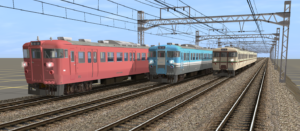
From left to right: All-over red livery (2010-202X), Nanao Line livery (1991-2012) and Fukuchiyama Line livery (1991 only).
DOWNLOAD
This is a reskin of Keinchiro’s 113 Series upgraded by Hirochi. All the necessary dependencies are included in this package or are avaible on the DLS.
In 1991, the Nanao Line in Ishikawa prefecture was electrified to enable direct and faster trains from Osaka and Nagoya to reach the Noto Peninsula, a popular tourist destination served by the line.
As the Nanao Line had been built a non-electrified line, the numerous tunnels on the line restricted the loading gauge, meaning that the 20Kv 60Hz electrification of the Hokuriku Main Line (from wich the Nanao Line branches off) couldn’t be used, as AC electrification requires large clearances due to the higher catenary voltage. The line was instead electrified at 1500v DC.
With the electrification completed, JR West was now looking for a suitable commuter EMU to use on the line, but as the Nanao Line had a low ridership, buying new trains was seen as a waste, especially given the disastrous situation on most of JR West’s main commuter lines (such as the Tokaido Main Line local services).
At the same time, JR West had a surplus of AC/DC equipment from former limited express 485 Series trains wich had been converted to the DC-only 183 Series. Their new 207 Series was also planned to replace most of the 113 Series trains in use around Osaka, especially those on the Fukuchiyama Line.
The solution to this problem came out as a natural, but interesting one: convert surplus 113 Series trains to AC/DC capability with surplus 485 Series equipment!
Conversion of the first surplus Fukuchiyama Line 113-800 Series trains began in 1990 at JR West’s Suita, Takatori and Matsuto workshops, and at the same time they were re-formed in fixed 3-car sets and reclassified as “415-800 Series”. By early 1991, a total of 11 sets had been converted.
Due to an unexpected rise in ridership on the Fukuchiyama Line, a few newly-converted 415-800 Series trains were repainted into the line’s livery of cream with red and green line and briefly used (of course, in “DC mode” only) as temporary trains until 1991, when enough 207 Series trains had entered service on the line.
In early 1991 the whole 415-800 Series fleet was transferred to it’s new “home-line”, fitted in the Nanao Line’s own unique and disticntive livery of blue and dark grey for the KuHa cars and pink and dark grey for the MoHa cars.
Finally, the 415-800 Series entered service on the newly-electrified Nanao Line by mid-1991, where they’ve run ever since.
Starting from 2010, as the peculiar Nanao Line’s livery was costly to maintain, JR West decided to repaint the 415-800 Series fleet into an all-body dark reddish livery, replacing the old one by 2012.
Whith the exception of two sets (C01 and C04) retired in 2015, the whole 415-800 Series fleet is still in operation on the Nanano Line, but it’s retirement is imminent, as JR West has announced that they will be replaced by 521 Series trains that will be introduced on the line by Autumn 2020.
